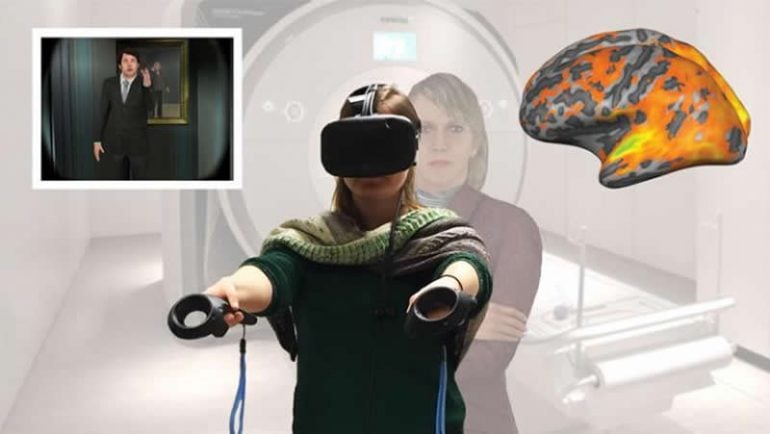Summary: First-person embodiment via virtual reality could help to treat those with empathy disorders. It could also assist violent offenders to develop an ability to empathize with their victims.
Source: SfN
Virtual reality activates brain networks that increase your ability to identify with other people, according to new research published in eNeuro. The technology could become a tool in the treatment of violent offenders to empathize more with others.
Understanding someone’s point of view is crucial for successful relationships. When this doesn’t come naturally, virtual reality technology may be able to help the process. A first-person perspective virtual reality experience providing multi-sensory feedback can coax the brain into thinking a virtual body is its own body. This causes the brain to react to virtual events as if they are happening in the real world.
de Borst et al. used functional magnetic resonance imaging to monitor the brain activity of participants while they experienced a virtual reality animation of a man verbally abusing a woman, from the perspective of the woman. Before watching the scene, the participants went through virtual reality training embodied as the woman or as a bystander watching the woman. People experiencing the first-person embodiment identified the woman’s body as their own and demonstrated synchronized brain activity in the personal space and body ownership networks. They also showed strong synchronized activity in parts of the brain processing threat perception when the man got close.
About this neuroscience research article
Source:
SfN
Media Contacts:
Calli McMurray – SfN
Image Source:
The image is credited to de Borst et al., eNeuro 2020.
Original Research: Closed access
“First Person Virtual Embodiment Modulates Cortical Network That Encodes the Bodily Self and Its Surrounding Space During the Experience of Domestic Violence”. by Aline W. de Borst, Maria V. Sanchez-Vives, Mel Slater and Beatrice de Gelder.
eNeuro doi:10.1523/ENEURO.0263-19.2019.
Abstract
First Person Virtual Embodiment Modulates Cortical Network That Encodes the Bodily Self and Its Surrounding Space During the Experience of Domestic Violence
Social aggression, such as domestic violence, has been associated with a reduced ability to take on others’ perspectives. In this naturalistic imaging study, we investigated whether training human participants to take on a first person embodied perspective during the experience of domestic violence enhances the identification with the victim and elicits brain activity associated with the monitoring of the body and surrounding space and the experience of threat. We combined fMRI measurements with preceding virtual reality exposure from either first or third person perspective to manipulate whether domestic abuse was perceived as directed to oneself or another. We found that first person perspective exposure increased body ownership and identification with the virtual victim. Furthermore, when the stimulus was perceived as directed towards oneself, the brain network that encodes the bodily self and its surrounding space was more strongly synchronized across participants and connectivity increased from premotor and intraparietal cortex towards superior parietal lobe. Additionally, when the stimulus came near the body, brain activity in the amygdala strongly synchronized across participants. Exposure to third person perspective reduced synchronization of brain activity in the personal space network, increased modulation of visual areas and strengthened functional connectivity between premotor cortex, supramarginal gyrus and primary visual cortex. In conclusion, our results suggest that first person perspective embodiment training enhances experience from the viewpoint of the virtual victim, which is accompanied by synchronization in the fronto-parietal network to predict actions towards the body and in the amygdala to signal the proximity of the stimulus.
Significance Statement
Using a combination of virtual reality and fMRI, our work reveals how first person perspective embodiment increases identification with the virtual victim during the experience of domestic abuse. We showed that when participants are embodied in the virtual victim the fronto-parietal brain network responsible for the representation of the bodily self and its surrounding space showed highly synchronized activity across participants when experiencing domestic abuse. Moreover, in this condition proximity of the aggressor strongly correlated with neural synchronization of the amygdala. We conclude that first person perspective embodiment allows participants to identify with the virtual victim through changes in this fronto-parietal network.
Feel Free To Share This Neuroscience News.







